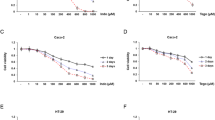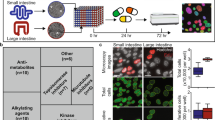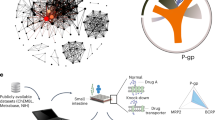Abstract
Aim:
Diclofenac is a non-steroidal anti-inflammatory drug (NSAID), which may cause serious intestinal adverse reactions (enteropathy). In this study we investigated whether co-administration of ciprofloxacin affected the pharmacokinetics of diclofenac and diclofenac-induced enteropathy in rats.
Methods:
The pharmacokinetics of diclofenac was assessed in rats after receiving diclofenac (10 mg/kg, ig, or 5 mg/kg, iv), with or without ciprofloxacin (20 mg/kg, ig) co-administered. After receiving 6 oral doses or 15 intravenous doses of diclofenac, the rats were sacrificed, and small intestine was removed to examine diclofenac-induced enteropathy. β-Glucuronidase activity in intestinal content, bovine liver and E coli was evaluated.
Results:
Following oral or intravenous administration, the pharmacokinetic profile of diclofenac displayed typical enterohepatic circulation, and co-administration of ciprofloxacin abolished the enterohepatic circulation, resulted in significant reduction in the plasma content of diclofenac. In control rats, β-glucuronidase activity in small intestinal content was region-dependent: proximal intestine<distal intestine<ileal valve. Administration of ciprofloxac caused significant reduction of β-glucuronidase activity in distal small intestine, and particularly in ileal valve. Furthermore, ciprofloxacin (10–2000 μmol/L) dose-dependently inhibited β-glucuronidase activity in distal small intestine content or E coli incubated in vitro, but did not affect that in proximal small intestine content or bovine liver incubated in vitro. After receiving 6 oral doses or 15 intravenous doses of diclofenac, typical enteropathy was developed with severe enteropathy occurred in distal small intestine. Co-administration of ciprofloxacin significantly alleviated diclofenac-induced enteropathy.
Conclusion:
Co-administration of ciprofloxacin attenuated enterohepatic circulation of diclofenac and alleviated diclofenac-induced enteropathy in rats, partly via the inhibition of intestinal β-glucuronidase activity.
Similar content being viewed by others
Log in or create a free account to read this content
Gain free access to this article, as well as selected content from this journal and more on nature.com
or
References
Gan TJ . Diclofenac: an update on its mechanism of action and safety profile. Curr Med Res Opin 2010; 26: 1715–31.
Wallace JL . Mechanisms, prevention and clinical implications of nonsteroidal anti-inflammatory drug-enteropathy. World J Gastroenterol 2013; 19: 1861–76.
Bjarnason I, Hayllar J, MacPherson AJ, Russell AS . Side effects of nonsteroidal anti-inflammatory drugs on the small and large intestine in humans. Gastroenterology 1993; 104: 1832–47.
Granfors MT, Backman JT, Neuvonen M, Neuvonen PJ . Ciprofloxacin greatly increases concentrations and hypotensive effect of tizanidine by inhibiting its cytochrome P450 1A2-mediated presystemic metabolism. Clin Pharmacol Ther 2004; 76: 598–606.
McLellan RA, Drobitch RK, Monshouwer M, Renton KW . Fluoroquinolone antibiotics inhibit cytochrome P450-mediated microsomal drug metabolism in rat and human. Drug Metab Dispos 1996; 24: 1134–8.
Nix DE, DeVito JM, Whitbread MA, Schentag JJ . Effect of multiple dose oral ciprofloxacin on the pharmacokinetics of theophylline and indocyanine green. J Antimicrob Chemother 1987; 19: 263–9.
Schwartz J, Jauregui L, Lettieri J, Bachmann K . Impact of ciprofloxacin on theophylline clearance and steady-state concentrations in serum. Antimicrob Agents Chemother 1988; 32: 75–7.
Mahr G, Sorgel F, Granneman GR, Kinzig M, Muth P, Patterson K, et al. Effects of temafloxacin and ciprofloxacin on the pharmacokinetics of caffeine. Clin Pharmacokinet 1992; 22: 90–7.
Raaska K, Neuvonen PJ . Ciprofloxacin increases serum clozapine and N-desmethylclozapine: a study in patients with schizophrenia. Eur J Clin Pharmacol 2000; 56: 585–9.
Herrlin K, Segerdahl M, Gustafsson LL, Kalso E . Methadone, ciprofloxacin, and adverse drug reactions. Lancet 2000; 356: 2069–70.
Vlase L, Popa A, Neag M, Muntean D, Leucuta SE . Pharmacokinetic interaction between zolpidem and ciprofloxacin in healthy volunteers. Eur J Drug Metab Pharmacokinet 2011; 35: 83–7.
Erol H, Beder N, Caliskan T, Dundar M, Unsal A, Culhaci N . Can the effect of antibiotherapy and anti-inflammatory therapy on serum PSA levels discriminate between benign and malign prostatic pathologies? Urol Int 2006; 76: 20–6.
Huber CE, LaBerge T, Schwiesow T, Carroll K, Bernstein PS, Mamalis N . Exophiala werneckii endophthalmitis following cartaract surgery in an immunocompetent individual. Ophthalmic Surg Lasers 2000; 31: 417–22.
Khan HA, Amitava AK . Topical diclofenac versus dexamethasone after strabismus surgery: a double-blind randomized clinical trial of anti-inflammatory effect and ocular hypertensive response. Indian J Ophthalmol 2007; 55: 271–5.
Borrows R, Chusney G, James A, Stichbury J, Van Tromp J, Cairns T, et al. Determinants of mycophenolic acid levels after renal transplantation. Ther Drug Monit 2005; 27: 442–50.
Borrows R, Chusney G, Loucaidou M, James A, Van Tromp J, Cairns T, et al. The magnitude and time course of changes in mycophenolic acid 12-hour predose levels during antibiotic therapy in mycophenolate mofetil-based renal transplantation. Ther Drug Monit 2007; 29: 122–6.
Kodawara T, Masuda S, Yano Y, Matsubara K, Nakamura T, Masada M . Inhibitory effect of ciprofloxacin on beta-glucuronidase-mediated deconjugation of mycophenolic acid glucuronide. Biopharm Drug Dispos 2014; 35: 275–83.
Peris-Ribera JE, Torres-Molina F, Garcia-Carbonell MC, Aristorena JC, Pla-Delfina JM . Pharmacokinetics and bioavailability of diclofenac in the rat. J Pharmacokinet Biopharm 1991; 19: 647–65.
Tabata K, Yamaoka K, Fukuyama T, Nakagawa T . Evaluation of intestinal absorption into the portal system in enterohepatic circulation by measuring the difference in portal-venous blood concentrations of diclofenac. Pharm Res 1995; 12: 880–3.
Fukuyama T, Yamaoka K, Ohata Y, Nakagawa T . A new analysis method for disposition kinetics of enterohepatic circulation of diclofenac in rats. Drug Metab Dispos 1994; 22: 479–85.
Tsuchiya T, Terakawa M, Ishibashi K, Noguchi H, Kato R . Disposition and enterohepatic circulation of diclofenac in dogs. Arzneimittelforschung 1980; 30: 1650–3.
LoGuidice A, Wallace BD, Bendel L, Redinbo MR, Boelsterli UA . Pharmacologic targeting of bacterial beta-glucuronidase alleviates nonsteroidal anti-inflammatory drug-induced enteropathy in mice. J Pharmacol Exp Ther 2012; 341: 447–54.
Saitta KS, Zhang C, Lee KK, Fujimoto K, Redinbo MR, Boelsterli UA . Bacterial beta-glucuronidase inhibition protects mice against enteropathy induced by indomethacin, ketoprofen or diclofenac: mode of action and pharmacokinetics. Xenobiotica 2014; 44: 28–35.
Boelsterli UA, Redinbo MR, Saitta KS . Multiple NSAID-induced hits injure the small intestine: underlying mechanisms and novel strategies. Toxicol Sci 2013; 131: 654–67.
al-Khamis KI, Jim LK, Bawazir SA, Ashour LF, el-Sayed N, el-Sayed YM . Effect of famotidine on ciprofloxacin pharmacokinetics after single intravenous and oral doses in rats. J Clin Pharm Ther 1994; 19: 335–9.
Huntjens DR, Strougo A, Chain A, Metcalf A, Summerfield S, Spalding DJ, et al. Population pharmacokinetic modelling of the enterohepatic recirculation of diclofenac and rofecoxib in rats. Br J Pharmacol 2008; 153: 1072–84.
Torres-Lopez JE, Lopez-Munoz FJ, Castaneda-Hernandez G, Flores-Murrieta FJ, Granados-Soto V . Pharmacokinetic-pharmacodynamic modeling of the antinociceptive effect of diclofenac in the rat. J Pharmacol Exp Ther 1997; 282: 685–90.
Zhu M, Wong PY, Li RC . Influence of Sanguisorba officinalis, a mineral-rich plant drug, on the pharmacokinetics of ciprofloxacin in the rat. J Antimicrob Chemother 1999; 44: 125–8.
Jiang S, Zhao W, Chen Y, Zhong Z, Zhang M, Li F, et al. Paroxetine decreased plasma exposure of glyburide partly via inhibiting intestinal absorption in rats. Drug Metab Pharmacokinet 2015; 30: 240–6.
Sutton SC, Rinaldi MT, Vukovinsky KE . Comparison of the gravimetric, phenol red, and 14C-PEG-3350 methods to determine water absorption in the rat single-pass intestinal perfusion model. AAPS PharmSci 2001; 3: E25.
Li F, Wang D, Xu P, Wu J, Liu L, Liu X . Identification of the metabolites of anti-inflammatory compound clematichinenoside AR in rat intestinal microflora. Biomed Chromatogr 2013; 27: 1767–74.
Zhang J, Li P, Guo HF, Liu L, Liu XD . Pharmacokinetic-pharmacodynamic modeling of diclofenac in normal and Freund's complete adjuvant-induced arthritic rats. Acta Pharmacol Sin 2012; 33: 1372–8.
Kodawara T, Higashi T, Negoro Y, Kamitani Y, Igarashi T, Watanabe K, et al. The inhibitory effect of ciprofloxacin on the beta-glucuronidase-mediated deconjugation of the irinotecan metabolite SN-38-G. Basic Clin Pharmacol Toxicol 2016; 118: 333–7.
Hawksworth G, Drasar BS, Hill MJ . Intestinal bacteria and the hydrolysis of glycosidic bonds. J Med Microbiol 1971; 4: 451–9.
Xia B, Zhou Q, Zheng Z, Ye L, Hu M, Liu Z . A novel local recycling mechanism that enhances enteric bioavailability of flavonoids and prolongs their residence time in the gut. Mol Pharm 2012; 9: 3246–58.
Syer SD, Blackler RW, Martin R, de Palma G, Rossi L, Verdu E, et al. NSAID enteropathy and bacteria: a complicated relationship. J Gastroenterol 2015; 50: 387–93.
Atchison CR, West AB, Balakumaran A, Hargus SJ, Pohl LR, Daiker DH, et al. Drug enterocyte adducts: possible causal factor for diclofenac enteropathy in rats. Gastroenterology 2000; 119: 1537–47.
LoGuidice A, Ramirez-Alcantara V, Proli A, Gavillet B, Boelsterli UA . Pharmacologic targeting or genetic deletion of mitochondrial cyclophilin D protects from NSAID-induced small intestinal ulceration in mice. Toxicol Sci 2010; 118: 276–85.
Ramirez-Alcantara V, LoGuidice A, Boelsterli UA . Protection from diclofenac-induced small intestinal injury by the JNK inhibitor SP600125 in a mouse model of NSAID-associated enteropathy. Am J Physiol Gastrointest Liver Physiol 2009; 297: G990–8.
Reuter BK, Davies NM, Wallace JL . Nonsteroidal anti-inflammatory drug enteropathy in rats: role of permeability, bacteria, and enterohepatic circulation. Gastroenterology 1997; 112: 109–17.
Seitz S, Boelsterli UA . Diclofenac acyl glucuronide, a major biliary metabolite, is directly involved in small intestinal injury in rats. Gastroenterology 1998; 115: 1476–82.
Acknowledgements
The project was supported by the Priority Academic Program Development of Jiangsu Higher Education Institutions and the Policy Directive Program of Jiangsu Province (BY2015072-03).
Author information
Authors and Affiliations
Corresponding authors
Rights and permissions
About this article
Cite this article
Zhong, Zy., Sun, Bb., Shu, N. et al. Ciprofloxacin blocked enterohepatic circulation of diclofenac and alleviated NSAID-induced enteropathy in rats partly by inhibiting intestinal β-glucuronidase activity. Acta Pharmacol Sin 37, 1002–1012 (2016). https://doi.org/10.1038/aps.2016.54
Received:
Accepted:
Published:
Issue date:
DOI: https://doi.org/10.1038/aps.2016.54
Keywords
This article is cited by
-
Diabetes downregulates peptide transporter 1 in the rat jejunum: possible involvement of cholate-induced FXR activation
Acta Pharmacologica Sinica (2020)
-
Human microbiome signatures of differential colorectal cancer drug metabolism
npj Biofilms and Microbiomes (2017)
-
Acute liver failure enhances oral plasma exposure of zidovudine in rats by downregulation of hepatic UGT2B7 and intestinal P-gp
Acta Pharmacologica Sinica (2017)
-
Real-time imaging of intestinal bacterial β-glucuronidase activity by hydrolysis of a fluorescent probe
Scientific Reports (2017)
-
Impact of gut microbiota on drug metabolism: an update for safe and effective use of drugs
Archives of Pharmacal Research (2017)



